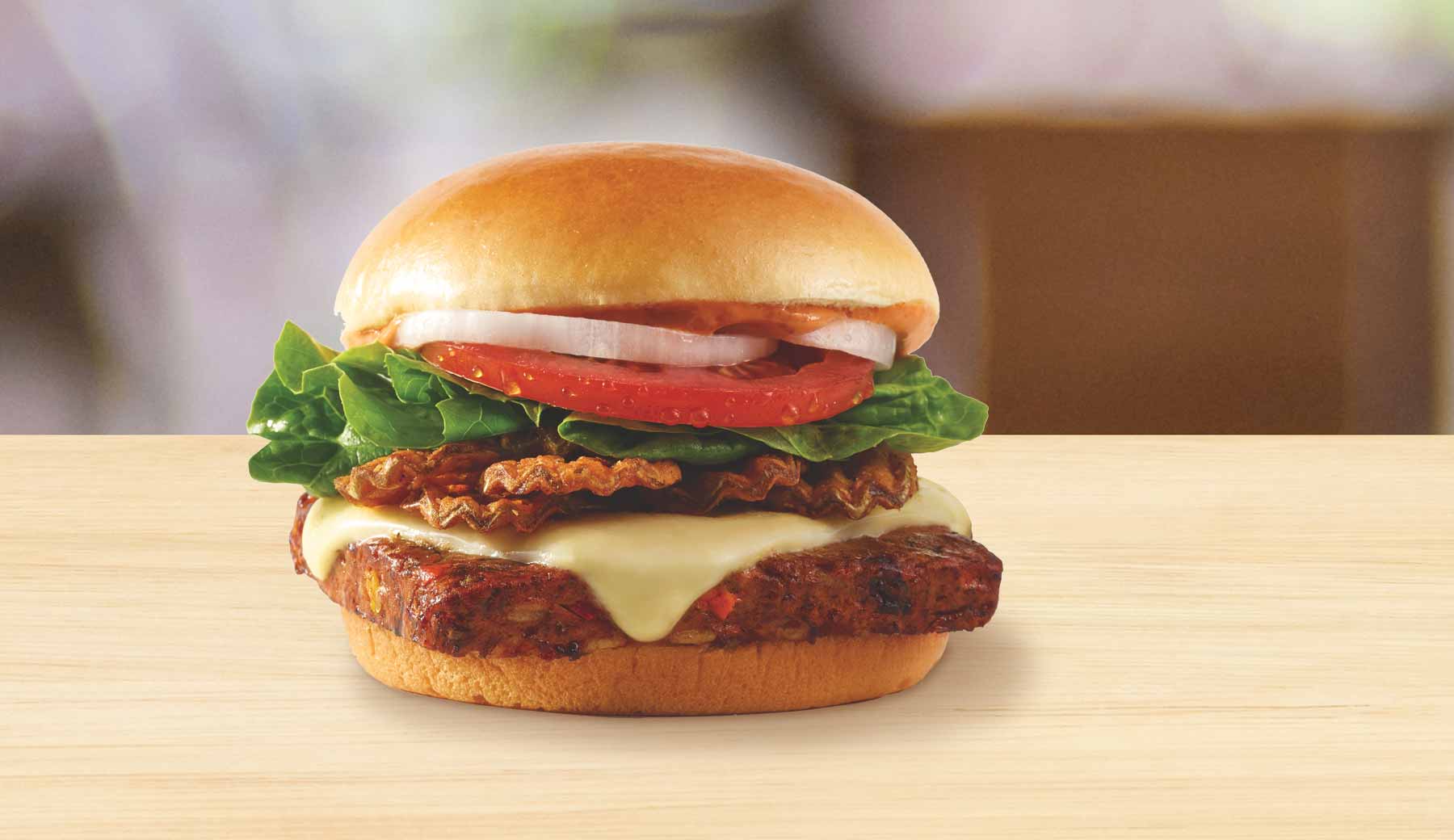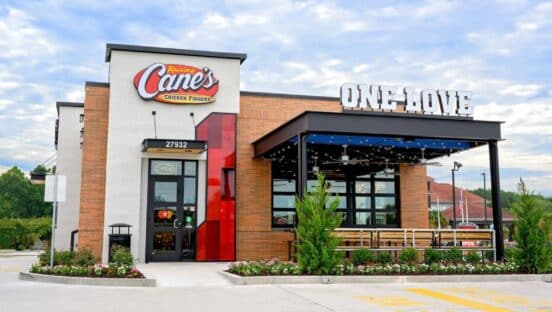Wendy’s spent a great deal of time searching for its next entrant into the growing plant-based category.
The fast-food chain landed on the Spicy Black Bean Burger, a creation that John Li, vice president of culinary innovation, describes as “not your parents or your grandparents’ black bean burger.” The latest piece of innovation is being tested in the Columbus, Pittsburgh, and Jacksonville markets. Li estimates that Eryn Bennett, manager of culinary production and innovation, and her team explored more than 70 to 80 options during the process.
“We have a lot of equity and a lot of strength and a lot of understanding in terms of what our customers want,” Li says. “Part of it is flavor. In the world of plant-based protein, there are a lot of products out there that are just substitutes, and they end up getting built in sandwiches that I call ‘OK.’ They’re not flavorful. The way [Eryn] built this, it really is craveable. … I don’t miss eating meat when I eat that [Spicy Black Bean Burger].”
The plant-based movement has taken the restaurant industry by storm in recent years. In 2019, Burger King launched the Impossible Whopper nationwide. In February, McDonald’s announced it established a three-year agreement with Beyond Meat, designating the company as its preferred supplier for the patty in the McPlant, which the chain is testing in select markets. Even more recently, Taco Bell revealed it’s testing a Naked Chalupa with a crispy plant-based shell.
For Wendy’s, the focus is on spice. In addition to the Spicy Black Bean Burger, the brand launched the Jalapeño Popper Chicken Sandwich and Salad in February, and in a few weeks, it will roll out a new Ghost Pepper Ranch sauce to pair with its chicken nuggets. In terms of comparison, Wendy’s ranks the spice level of a Spicy Black Bean Burger around a six, while the Spicy Chicken Sandwich and Spicy Nuggets are a seven. The Jalapeño Popper Chicken Sandwich is an eight.
Wendy’s recently held a virtual Culinary Spotlight event showcasing the new Spicy Black Bean Burger. Li and Bennett gave a behind-the-scenes look at the innovation, and explained how it arrived on the menu. QSR attended the event and captured the highlights.
Can you talk a little bit more about how Wendy’s is bringing the heat and spicing things up this summer?
John Li: We know the plant-based protein category is growing. It continues to grow. It’s hot. I think the prediction is $40 billion by 2025. By 2030, $50 to $60 billion. It’s a category that we have been playing in for quite some time, but we haven’t rushed to introduce anything because of this idea that going to meatless doesn’t have to equal flavorless, and it’s that pressure on our team—and we love this pressure by the way—to develop something that does it in a Wendy’s way. So it’s about the “fast food done right” pillars. And it took a year, maybe a little more, a lot of iterative prototyping, a lot of harassment from me, making sure we get it as good as we possibly can get it so we’re proud of it.
The reason why it took a year and a half was because we wanted to develop something that we loved. If we didn’t like it, we’re not going to put it out there for the consumers. We could have gone a lot of different routes. A lot of our competitors have gone a different route than us. We wanted to make sure that we’re not going to follow everybody. We’re going to do in a way that makes sense for us.
Eryn Bennett: When we start thinking about products, we take a look at what’s out there today. I know I’m a black bean and veggie burger consumer at heart, and a lot of times I leave restaurants really disappointed. Sometimes there’s just no flavor. It’s bland, it’s boring. Other times you get it, the texture, it just completely falls apart, or it’s really mushy. So we wanted to make sure we were doing the complete opposite of that. So we actually started by really just going to the grocery store and buying all of our favorite ingredients that would go into a black bean patty, and making something from scratch in our test kitchen. So that’s a lot of fun, and we were able to incorporate a ton of awesome ingredients into the patty itself. So of course there’s black beans in there, we have some chickpeas, there’s brown rice, carrots, corn, green and red bell peppers—you name it—there’s just chock full of awesome veggies, making this a really great plant-based patty.
So beyond the patty, we wanted to really focus on having some texture and flavor contrast. As I mentioned, not wanting to have that mushy boring experience that we see in so many other places. So we’ve added a lot of really nice, crisp fresh produce. We have onions, tomatoes, romaine lettuce. Then we have this really cool new ingredient—crispy chipotle jalapeño. So they’re actually jalapeños that are seasoned with a chipotle seasoning that perfectly complements the spicy black bean patty itself. And then we top it with a chipotle sauce.
So all of those ingredients really come together in addition to a nice, creamy cool pepper jack cheese that just adds an extra element to make this sandwich super craveable. When you bite into it, you get that amazing contrast. It’s not bland, it’s not boring. It’s spicy, but I like to think of it as an approachable spice where when you bite into it you’re like, ‘OK, I can eat this.’ I might not be able to eat something that’s crazy hot like a scorpion pepper, but this is just something that really is, like I said, an approachable spice that I think all of our fans will really, really love. And the other thing is, it’s not a substitute for meat. This is something that can stand on its own on our Made to Crave menu because it is so bold and flavorful.
Why black bean as a plant protein source?
John Li: It’s not just a black bean. It’s all the components together that give it the right texture, the right flavor, and nutritional profile that we felt good about. Now we’re focused on taste first. Make no doubt about it. Big “T,” little “N” is what I call it. Get the taste right, make sure it looks fantastic. Nutrition comes second.
Eryn Bennett: The other thing I would add to that is, the black bean is something that’s familiar to our consumers. I think if we were to [offer] like a quinoa kale burger or something that’s a little bit more further out, that’s just not going to resonate with our consumer. So we wanted to have that flex option, but also make it something that our consumers would know and understand and be open to trying versus just being blown away and not open to what the offering is.
Is the Spicy Black Bean Burger a vegetarian option?
Eryn Bennett: It’s really meant to be a flexitarian option. Because of the other items on our lineup in our restaurants, it’s a little bit harder to call something out as truly vegetarian. Really truly designed with that flexitarian in mind.
Has a Spicy Black Bean Burger been in development since all the other chains jumped on board to the Impossible/Beyond train?
John Li: Yes, we were in development. When I came on board [in February 2019], we already had the inklings and the seedlings for a black bean burger, which we’ve evolved into what Eryn’s developed now.
Eryn Bennett: We actually tested one a couple of years ago in the spirit of innovation because that’s what we do. It’s one of those things where you have something and it’s good, but you always want to keep trying to see if you can just make something a little bit better, and our journey really doesn’t stop until the product launches nationally in restaurants. So we’re always going to make sure the product is the best that it can be. We love the product we had before, but since we had a little bit of time, we worked through and just made sure we were super passionate about the product and giving the consumers exactly what they were asking for.
How long before we might see the new Spicy Black Bean Burger in a larger market?
John Li: We really think that it’s going to do well in these three markets. So that’s really going to dictate how we think about a national launch across the U.S. So more to come. It’s all about getting some measurements on how this does in the three markets. I’m hoping that we’ll know a lot by probably early August.







